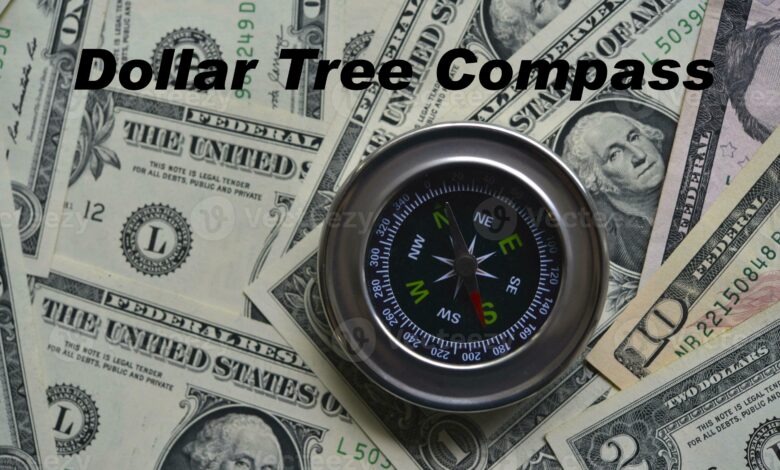Dollar Tree Compass: Budget-Friendly Navigation or Just a Fun Find?

When most people think of Dollar Tree Compass, they think of affordable snacks, seasonal décor, or basic household items. But walk a little deeper into the aisles, and you’ll notice an interesting range of tools and accessories, including the Dollar Tree compass. Now, at first glance, you might be wondering: can a compass that costs just a dollar really work? Or is it more of a novelty item for kids and casual adventurers? That’s exactly what we’re going to explore today. Whether you’re curious about its usefulness for outdoor trips, its potential as an educational tool, or simply its role as a budget-friendly buy, this little gadget has more depth than you might expect.
What Exactly Is the Dollar Tree Compass?
A Dollar Tree compass is a simple navigation tool sold at the popular dollar store chain. Unlike high-end compasses that can cost $20, $50, or even more, this one is priced at just $1.25 (depending on your local store). It usually comes in lightweight plastic housing and sometimes is paired with other outdoor tools like whistles, carabiners, or mini flashlights.
On a functional level, the Dollar Tree Compass is designed to do what any compass should—point north. But because of its budget build, its accuracy and durability may not be on par with professional compasses. Still, that doesn’t mean it’s useless. Many people grab them as fun little gadgets for kids, camping starter packs, or even as backup navigation tools. It’s definitely not something you’d rely on for serious survival or military-grade tasks, but it’s a surprisingly interesting find for casual use.
What makes it particularly appealing is the accessibility. Anyone can walk into a Dollar Tree Compass, grab a compass for a buck, and immediately introduce themselves (or their kids) to the concept of navigation without investing in expensive gear. For a store that thrives on providing affordable options, the compass fits right in.
Is It Reliable for Real Navigation?

Now, let’s get real for a second—if you’re hiking deep into the wilderness, relying solely on a Dollar Tree compass is probably not the smartest idea. Its lightweight build and basic magnetic needle can sometimes be off by a few degrees. While this margin of error might not matter if you’re just teaching your child how a compass works, it could matter a lot if you’re trying to find your way back to camp in the middle of a forest.
That being said, many people who’ve tested the Dollar Tree compass say it actually does work fairly well for general direction. If all you need to know is “which way is north” while you’re at a local park or campground, it’ll do the job. It’s when you start expecting precision and rugged durability that you might run into disappointment.
Another factor to consider is durability. These compasses are typically made of plastic, which means they can crack, leak, or lose magnetism if handled roughly. For occasional use, though, especially in low-stakes situations, it’s a surprisingly functional tool. Think of it less as a survival device and more as an affordable introduction to navigation Dollar Tree Compass.
Perfect for Kids and Learning Purposes
One of the best uses for a Dollar Tree compass is as an educational tool. Kids are naturally curious about direction, maps, and the idea of finding their way. Instead of handing them a pricey professional compass, parents and teachers can use a Dollar Tree version as a starter tool.
In classrooms, a Dollar Tree Compass like this can be used during geography lessons or science projects to help children understand how the Earth’s magnetic field works. Kids can learn the difference between cardinal directions (north, south, east, and west) and even explore how navigation was done long before GPS and smartphones existed.
At home, parents can turn it into a fun game. Imagine sending your child on a mini treasure hunt in the backyard using only a Dollar Tree Compass and a simple map. It’s educational, affordable, and—let’s face it—way more fun than just explaining directions verbally. Even if the compass breaks or gets lost, replacing it won’t break the bank. That’s the beauty of Dollar Tree finds.
Camping and Outdoor Use
If you’re someone who enjoys casual camping or light hiking, the Dollar Tree compass can still come in handy. It’s not going to replace your GPS or a high-end navigation kit, but it can act as a backup tool. Imagine your phone dies while you’re on a short trail—pulling out even a basic compass can at least help you figure out the general direction to head back.
Another underrated use is keeping a few of these compasses as part of a group activity. For example, if you’re leading a scout group, youth camp, or family outdoor event, handing out Dollar Tree compasses allows everyone to participate in navigation challenges without needing to buy multiple expensive ones. It builds teamwork and teaches practical survival skills, all for a very small cost.
Of course, if you’re an experienced outdoorsman who spends days off-grid, you already know that investing in a professional-grade compass is the smarter move. But for casual adventurers, the Dollar Tree compass strikes a good balance between cost and basic functionality.
Collectible or Novelty Value
Interestingly, some people buy Dollar Tree compasses not because they need them, but because they like collecting quirky items. The compass often comes in different designs, sometimes attached to a keychain or bundled with other tools, making it a fun novelty.
For collectors of budget gadgets, these little compasses serve as conversation starters. Imagine showing off your collection of “dollar store survival gear”—it’s both amusing and oddly impressive. Plus, for DIY enthusiasts, the Dollar Tree compass can even be repurposed into crafts, costume props, or decorative projects.
In that sense, it’s more than just a tool—it’s a piece of budget-friendly creativity. For only a Dollar Tree Compass, it’s hard not to see the charm in owning one.
When You Shouldn’t Rely on It
As much as the Dollar Tree compass has its merits, it’s important to highlight when not to use it. If you’re planning serious outdoor travel, like multi-day hikes, mountain climbing, or survival expeditions, you’ll want a professional-grade compass with proven accuracy and durability. Depending solely on a $1 tool in such high-risk scenarios could lead to serious trouble.
Also, if you need a compass for technical navigation tasks, like using a detailed topographic map, the slight inaccuracies of a Dollar Tree compass could make a big difference. In those situations, precision matters. Think of the Dollar Tree compass more as a toy, a backup, or a learning tool—not a mission-critical device.
The Final Verdict: Worth It or Not?
So, is the Dollar Tree compass worth buying? Absolutely—if you understand what it’s for. It’s not going to replace your Garmin GPS or your military-grade Silva compass, but it doesn’t need to. For a dollar, you’re getting a functional, fun, and educational little gadget that introduces you (or your kids) to the basics of navigation.
If you’re a parent, teacher, casual camper, or simply someone who loves collecting budget-friendly tools, the Dollar Tree compass is a great pick. On the other hand, if you’re a serious outdoorsman who needs flawless accuracy in challenging environments, it’s best to invest in higher-quality equipment.
At the end of the day, the Dollar Tree compass perfectly represents what the store itself is all about: affordable, accessible, and surprisingly useful in the right context.
